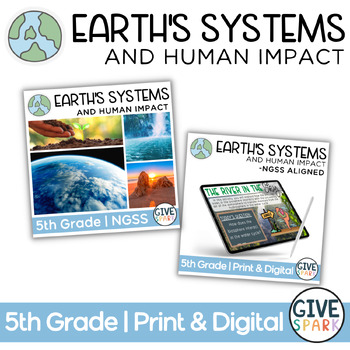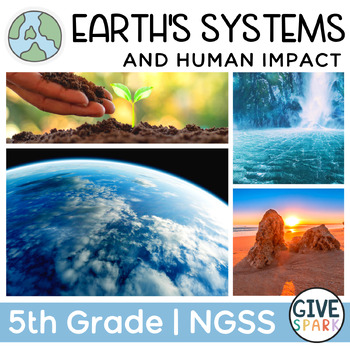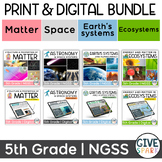5th Grade - Earth's Systems & Human Impact - PRINT AND DIGITAL bundle - NGSS
- Zip

Products in this Bundle (2)
Also included in
- Fifth Grade NGSS: The Ultimate Teaching Bundle – Print & Digital!Get ready for an exciting teaching journey with this all-in-one bundle, perfect for fifth-grade teachers. This package features four highly engaging science units, meticulously aligned with the Next Generation Science Standards (NGPrice $90.00Original Price $119.80Save $29.80
Description
5th Grade - Earth's Systems & Human Impact - PRINT AND DIGITAL bundle - NGSS Super Bundle
This comprehensive teaching unit is specifically designed for fifth-grade students to learn about the topic of matter.
Standards Alignment:
The unit consists of 13 engaging lessons that incorporate hands-on activities. It is fully aligned with the Next Generation Science Standards (NGSS) for fifth grade, specifically covering standards 5-ESS2-2, 5-ESS3-1, 5-ESS2-1.
PRINT AND DIGITAL FORMATS:
Enjoy flexibility, with all activities available in both print and digital versions. The digital version is hosted on Google Slides and comes with options such as narrated audio lessons, video science lab demonstrations, and other activities allowing for easier differentiation and self-paced student learning.
APPROACH TO LEARNING
Unlock your students' natural curiosity and passion for science with this interactive and hands-on teaching unit. Designed to connect with their prior knowledge and provide immersive experiences, this unit offers lessons that guide students through complex scientific principles in an accessible way. Students will actively participate in hands-on experiments and activities that make learning exciting and memorable. This unit promotes independent learning and encourages students to reflect on their understanding, helping them build a solid foundation of knowledge in a fun and stimulating environment.
WHAT'S COVERED?
In this unit, we look at the following topics:
- Lesson 1 - What is Earth?
- Lesson 2 - What is the Hydrosphere?
- Lesson 3 - What is the Atmosphere?
- Lesson 4 -What is the Geosphere?
- Lesson 5 - What is the Biosphere?
- Lesson 6 - How does the hydrosphere interact with Earth's spheres?
- Lesson 7 -How does the atmosphere interact with Earth's spheres?
- Lesson 8 - How does the geosphere interact with Earth's spheres?
- Lesson 9 - How does the biosphere interact with Earth's spheres?
- Lesson 10 - How do humans impact the geosphere?
- Lesson 11 - How do humans impact the atmosphere?
- Lesson 12 - How do humans impact the biosphere?
- Lesson 13 - How do humans impact the hydrosphere?
Key Features:
- Printable Resources: Detailed lesson plans, student response journals, assessments, quizzes, hands-on investigations, science lab activities, vocabulary posters, guiding questions, an end-of-unit project, and much more. Everything you need in a tangible, ready-to-use format
- Digital Resources on Google Slides: Each lesson comes in a digital variant enriched with narrated audio slides. This ensures that students can engage with content at their own pace, making it particularly useful for remote learning, differentiated instruction, or for students who benefit from auditory learning. Interactive activities incorporated within these slides further enhance student engagement and understanding. All labs have a video demonstration version to allow for flexibility between in-person labs and digital labs.
For a more in-depth look at each component, please visit the individual product descriptions.
NEED HELP? Before leaving feedback:
- Email me at givesparkco@gmail.com
- submit a help ticket
- ask a question on the Q& A tab
Thanks for stopping by x
Vicky
TERMS OF USE - © Give Spark, PTE Ltd
This product is a premium digital download exclusive to my company. Its purchase permits use in a single classroom only. Adherence to copyright laws is crucial. Any redistribution, modification, resale, or online posting of this product or any of its components without prior consent from the author is strictly forbidden and will be pursued under the Digital Millennium Copyright Act. For any special permissions or inquiries, please reach out directly to me at victoria@give-spark.com.





